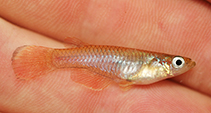| Diagnosis: |
Dorsal spines (total): 0-0; Dorsal soft rays (total): 5-6; Anal spines: 0-0; Anal soft rays: 14-17; Vertebrae: 25-26. Diagnosis: Poropanchax pepo is distinguished from all procatopodids except other Poropanchax by: the presence of a slightly curved, posteriorly directed, distal maxillary process vs. straight, anteromedially directed or deeply constricted; and the presence of a slender dentary vs. robust dentary (Ref. 122044). It is distinguished from all congeners by: a relative position of the first dorsal-fin ray to anal-fin rays of 11-14 vs. 5-10; the presence of rounded anal and dorsal fins in males vs. pointed; the presence of a dark humeral blotch in males vs. absence; and the absence of a sharp ventral process on the basipterygium vs. presence (Ref. 122044). It is further distinguished from all congeners except P. scheeli, by the presence of an open anterior supraorbital system vs. closed, and by the absence of bright bluish flank bands in males (Ref. 122044). It is similar to P. rancureli and distinct from other congeners in lacking filamentous pelvic fins vs. pelvic filaments present; other features not unique but useful for identification of Poropanchax pepo are the absence of a dark brown blotch on the lower jaw and preorbital area and the presence of a dark marginal band on the caudal-fin lobes (Ref. 122044).
Description: A large, strongly laterally compressed Poropanchax species; dorsal profile anterior to dorsal fin almost straight, ventral profile convex, greatest body depth approximately at distal tip of pelvic fin, caudal peduncle straight (Ref. 122044). Mouth directed upward, lower jaw protruding, much longer than upper jaw; outer row teeth on both jaws large, conical and slightly recurved; inner row teeth smaller, irregularly implanted; distal maxillary process slightly curved and posteriorly directed, dentary slender; no branchiostegal appendages in adult males (Ref. 122044). Dorsal fin rays 5-6; anal fin rays 14-17; first dorsal-fin ray above anal-fin ray 11-14; caudal fin rays 20-24; no dorsal, anal, or pelvic extensions in males; pelvic-fin rays 6; basipterygia lacking sharp ventral process; pectoral fin reaching one third to mid-pelvic fin in females, in males from mid-fin almost to tip of pelvic fin; pelvic fin just reaching urogenital aperture (Ref. 122044). Scales cycloid, body completely scaled except on ventral head surface; frontal squamation of G-type, G-scale as long as wide, double E scale present, F scae present and H scales variably present; no scales on dorsal- and anal-fin base, 2-3 scales over caudal-fin base; longitudinal series 24-27, transverse series at dorsal-fin insertion 6, circumpeduncular scale rows 10 (Ref. 122044). Frontal neuromasts small; preorbital sensory system in open groove with three neuromasts, postorbtal canal with two pores, preopercular canal with six pores; anterior supraorbital system in open groove with three exposed neuromasts; first neuromast anteriorly positioned; posterior portion in an open groove with three neuromasts (Ref. 122044).
Colouration: Colouration in life: snout brownish orange with scattered melanophores, iris silver; dorsum bright orange, flanks pale orange with bluish silver iridescence; ventrum from opercle to pelvic fins pale yellowish silver; humeral blotch present, but weakly pigmented; scales on flanks and dorsum reticulated; pectoral fins hyaline, remaining fins pumpkin orange; dorsal, anal, and pelvic fins with narrow white edge anteriorly, absent posteriorly; dorsal fin with two elongate interradial spots anteriorly, difficult to see in live specimens but prominent in preserved specimens; caudal fin with a dark greyish-black distal margin, extended dorsally in posterior third of fin; dorsally dark margin broad with light submarginal band, ventrally margin narrows and lacks submarginal band, giving caudal fin a characteristic asymmetrical patterning; caudal interradials with small dark melanophores extending to midfin (Ref. 122044). Female colouration in life unknown(Ref. 122044). Preserved males with dorsum and flanks pale yellowish brown, scaes reticulated; head pale, especially on snout and below eye; concentration of melanophores at third and/or fourth scale along midline forming humeral blotch; dorsal, anal, and caudal fins light grey; interradials of dorsal and anal fin greyish black; in some males caudal interradials are dark only at base, in most interradials are dark to midfin, and in some dark interradials extend to posterior margin; anal and dorsal fins with narrow light margin as in live specimens; caudal fin with black distal margin, extended dorsally in posterior third of fin; dark margin broad dorsally with light submarginal band, ventrally margin narrow and lacking a submarginal band; anteriorly dorsal fin with two elongated dark interradial spots (Ref. 122044). In females head, dorsum, and flanks as in males, but scale reticulation less marked or absent, and no humeral blotch evident; all fins light grey and immaculate (Ref. 122044). |
